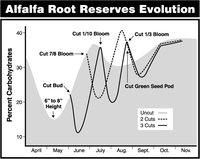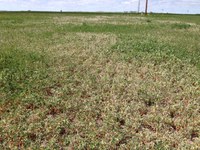Should Drought-stressed Alfalfa Be Clipped?
(Click an image below to view a high-resolution image that can be downloaded)
Many parts of the state where alfalfa is grown are experiencing moderate to severe drought, which is causing spring alfalfa growth to wilt, and shoots and leaves to dry.
“During drought, forage is likely in short supply and farmers are likely to try to get as much forage as possible,” says Marisol Berti, a forage and biomass production researcher at North Dakota State University. “But harvest timing decisions are important to keep a healthy and productive alfalfa stand.”
Alfalfa is a perennial crop, and keeping it perennial is important to have forage in the future, she notes. Whenever alfalfa plants are stressed, their response is to replenish the root and crown reserves (sugars, proteins) as soon as possible. Reserves are vital to support new growth from the buds in the crown once soil moisture is available.
The lowest root reserves occur when the plant is 6 to 8 inches tall in the spring before the first cut. Reserves are replenished about the time the plant blooms.
Drought-stressed alfalfa will flower early when still very short. The plant is accelerating its life cycle in an attempt to produce seed in the event that drought stress continues and the mother plant dies. If drought persists, alfalfa will drop its leaves and go dormant until conditions improve.
Alfalfa is well-adapted to survive a drought when managed correctly to avoid additional stresses on the plant, according to Berti.
The big question for producers is whether to clip or mow droughty alfalfa.
“Clipping drought-stressed alfalfa will not help the plant regrow faster when rainfall or moisture comes back,” Berti says.
She advises producers that if stands are not 12 to 15 inches tall or yield is not enough to cover the cost of harvest, they should leave the alfalfa uncut until rain falls and the alfalfa’s dormancy is broken. Clipping or harvesting droughty alfalfa at 6 to 8 inches would cause additional stress on the plant, reducing future regrowth and possibly causing plant death.
“Remember, the root reserves are at the lowest at 6 to 8 inches, so do not clip or mow alfalfa if shorter than 12 to 15 inches,” Berti stresses.
A common concern for farmers is that if the alfalfa flowers and never reaches 12 to 15 inches, will it flower again this year?
“The answer is yes,” Berti says. “If it rains and soil moisture conditions improve, buds in the alfalfa crown will grow new shoots. If soil moisture is available, the shoots will grow to a normal height for a second cut (18 to 22 inches). Then your harvest stage should be the 10 percent bloom stage to keep high-quality hay.”
Avoiding any additional stresses on the plant, such as nutrient deficiency or insects and diseases, is important. Berti recommends producers fertilize with phosphorus and potassium if they have not done so and their soil test indicates fertilization is needed. Potassium (potash) is particularly important because this nutrient helps the plant mobilize sugars back to the root to tolerate the drought stress.
“Also, when soil moisture is replenished, alfalfa will have all the nutrients it needs to resume a vigorous growth,” she adds.
NDSU Agriculture Communication - June 6, 2017
| Source: | Marisol Berti, 701-231-6110, marisol.berti@ndsu.edu |
|---|---|
| Editor: | Ellen Crawford, 701-231-5391, ellen.crawford@ndsu.edu |



